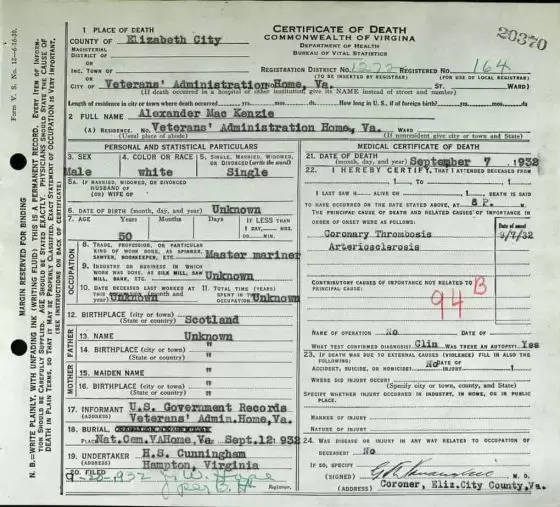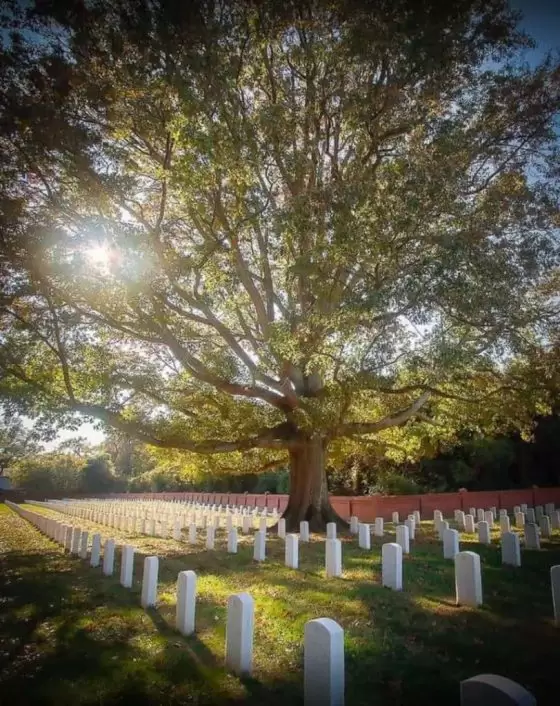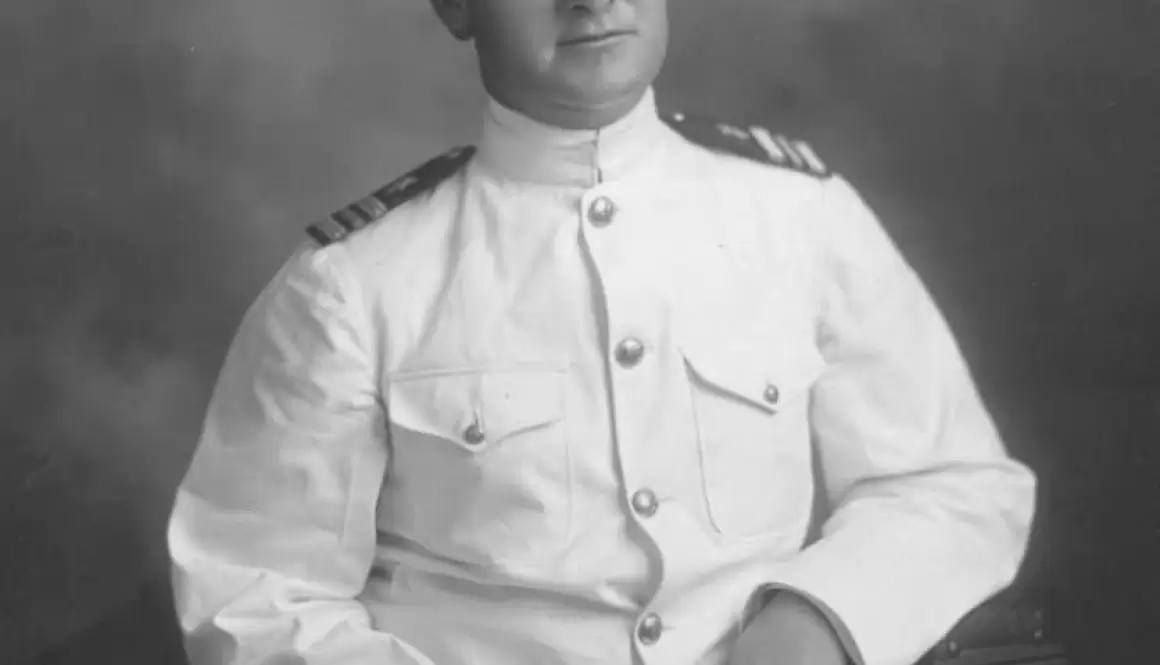Alexander MacKenzie Ex Meridian Tables
Alexander MacKenzie Ex Meridian Tables
Acknowledgement and Update
Since I first published this web page, I have been contacted by Ian Alexander Macleod, who chanced upon this website while searching for his, and indeed my, great grandfather Murdo MacKenzie. It turns out that Ian, who is my second cousin, has a lot more information than I did about Sandy MacKenzie. Much of this information came from his father, Dr John Macleod, who was Sandy’s nephew.
Ian tells me that his middle name of Alexander was given to him in honour of his great uncle Alexander “Sandy” MacKenzie.
I am grateful for all this additional information, and also for his permission to publish it on this web page. I have updated this page to include the additional information. August 2023.
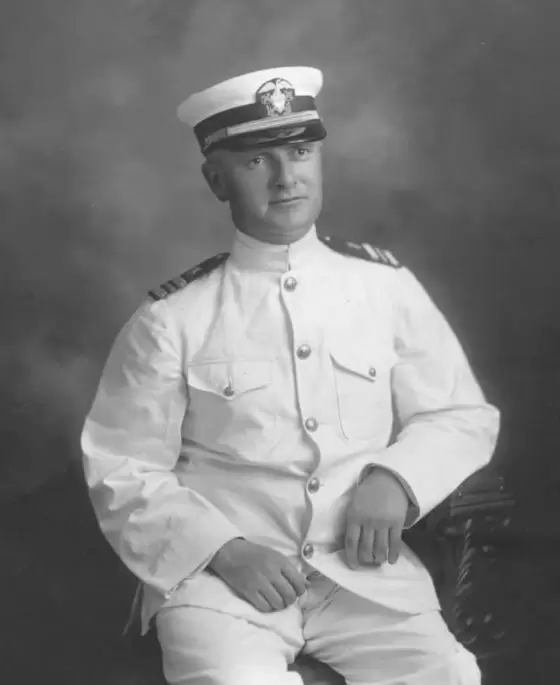
Alexander “Sandy” MacKenzie 1882-1932
Alexander MacKenzie was born at Shulishader, Isle of Lewis, Scotland on 15 September 1882. He was third child of Murdo MacKenzie and Ann MacLeod and the brother of my grandmother Henrietta MacKenzie.
His claim to fame was his book “MacKenzie’s Ex-Meridian Altitude Tables”. The main problem with using a sextant to calculate latitude was that it required a reading be taken of both the sun and the horizon at noon. If either the sun or the horizon was obscured by cloud at the stroke of noon, the reading would be inaccurate.
MacKenzie’s Tables enabled navigators to take a reading before or after noon and to calculate the adjustment necessary to obtain the correct latitude.
Sandy’s father and his grandfather had all been crofter fisherman, and the sea was in their blood. Going to sea must have seemed like the most obvious career choice in the world to Sandy.
Sandy’s grandfather Donald Mackenzie had been lost in a fishing accident in Broad Bay in 1859. Two of Donald’s brothers were on board at the same time. They were all lost and no bodies were ever recovered. This caused great hardship for the MacKenzie family
Birth Certificate
The extract from the Parish Register opposite, and marked in red, confirms the details of Alexander’s birth.
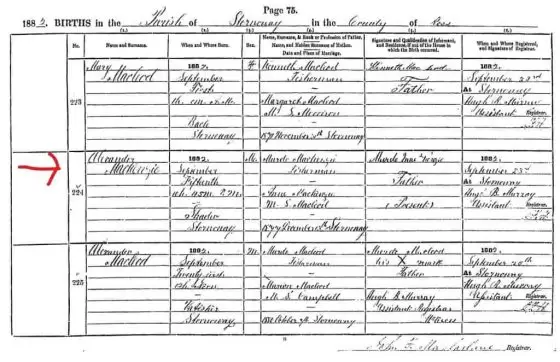
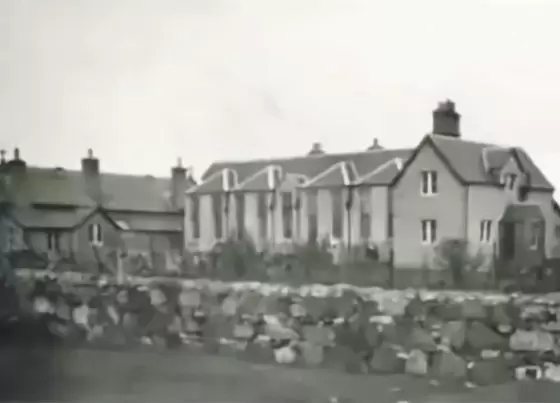
Early Years
Sandy MacKenzie is believed to have attended Aird School in Point. The school closed in 2011 and has since been demolished. I believe this to be the same school my father, Donald Thomson and his sister Jessie Ann Thomson attended, after they moved from Tong to Sheshader.
It is thought that Sandy might have run away from home at the age of 17 and possibly attended Nautical College in Glasgow before going to sea. Sandy’s father was always thought within the family, “to have ruled his family with a rod of iron”. In the light of this it is not hard to understand why Sandy might have run away.
However he spent his late teens, we know for certain that by the age of 20 in 1902 he had arrived in America as his date of arrival is confirmed on the 1920 Federal Census as 1902.
San Francisco Earthquake
It seems that at the beginning of the twentieth century Sandy was working on ships operating the “Clipper Route”. The Original Clipper Route was from the UK to Australia, but the American Clipper Route was a term used to describe the route from west coast ports to the east coast and back.
As the Panama Canal did not open until 1914, it was a route that followed the coast of South America and round Cape Horn, and became popular during the Californian Gold Rush in the middle of the nineteenth century.
As Sandy was in command of oil tankers for much of his later career, I would guess that he might have served his apprenticeship on oil tankers, shipping oil from the oilfields of California to the East Coast of America.
According to testimony from family members who knew Sandy, he found himself in San Francisco at the time of, or shortly after the San Francisco earthquake on 18 April 1906. He was involved in the rescue effort.
We know that he also sailed from Seattle as he applied for his Seaman’s Certificate there on 10 February 1909.
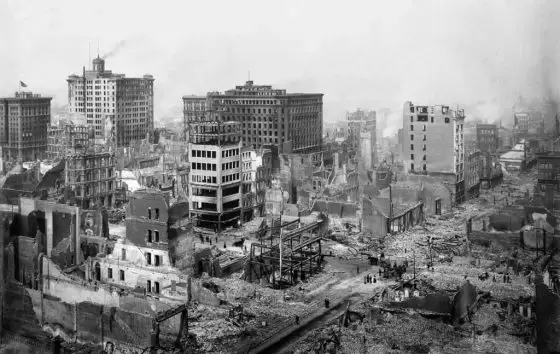
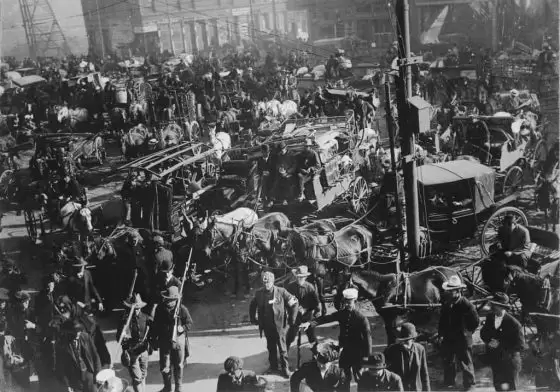
Evacuees leaving the City
A strong foreshock preceded the main shock by about 20 to 25 seconds. The strong shaking of the main shock lasted about 42 seconds. There were decades of minor earthquakes – more than at any other time in the historical record for northern California – before the 1906 quake.
Previously interpreted as precursory activity to the 1906 earthquake, they have been found to have a strong seasonal pattern and are now believed to be caused by large seasonal sediment loads in coastal bays that overlie faults as a result of the erosion caused by hydraulic mining in the later years of the California Gold Rush
Robert Peary
According to oral tradition in our family, Sandy was invited by Commander Robert Peary to be his navigator on his expedition to be the first person to reach the North Pole, but Sandy declined.
Robert Edwin Peary Sr. was an American explorer and officer in the United States Navy who made several expeditions to the Arctic in the late 19th and early 20th centuries. He is best known for, in April 1909, leading an expedition that claimed to be the first to have reached the geographic North Pole.
Peary made his first expedition to the Arctic in 1886, intending to cross Greenland by dog sled, taking the first of his own suggested paths. He was given six months’ leave from the Navy, and he received $500 from his mother to book passage north and buy supplies. He sailed on a whaler to Greenland, arriving in Godhavn on June 6, 1886. Peary wanted to make a solo trek, but Christian Maigaard, a young Danish official, convinced him he would die if he went out alone. Maigaard and Peary set off together and traveled nearly 100 mi (160 km) due east before turning back because they were short on food. This was the second-farthest penetration of Greenland’s ice sheet at the time. Peary returned home knowing more of what was required for long-distance ice trekking.
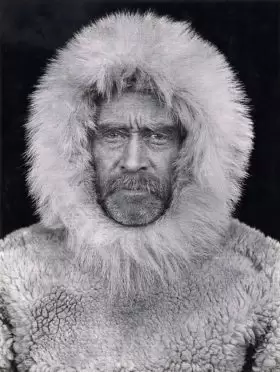
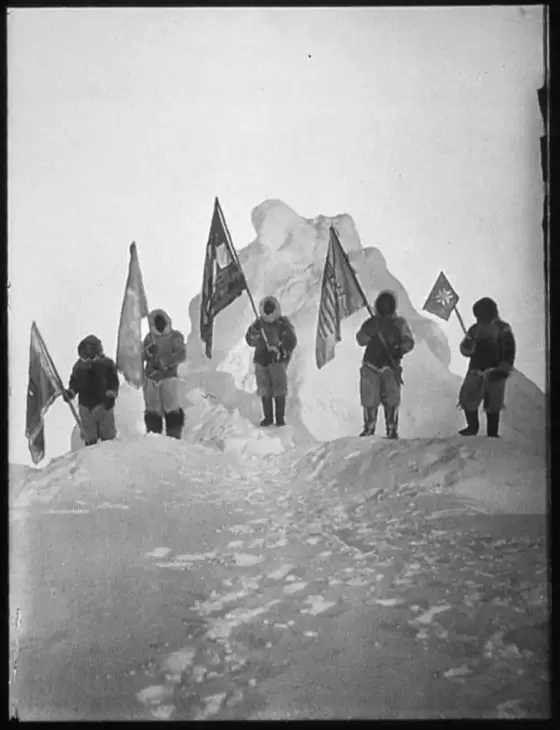
North Pole
On July 6, 1908, the Roosevelt departed New York City with Peary’s eighth Arctic expedition of 22 men. Besides Peary as expedition commander, it included master of the Roosevelt Robert Bartlett, surgeon Dr. J.W. Goodsell, along with Ross Gilmore Marvin, Donald Baxter MacMillan, George Borup, and Matthew Henson. After recruiting several Inuit and their families at Cape York (Greenland), the expedition wintered near Cape Sheridan on Ellesmere Island.
On the final stage of the journey toward the North Pole, Peary told Bartlett to stay behind. He continued with five others: Henson, Ootah, Egigingwah, Seegloo, and Ooqueah. No one except Henson, who had served on the Peary expedition to Greenland of 1891–1892, had experience of naval-type observations.
On April 6, 1909, Peary established Camp Jesup within 3 miles of the pole, according to his own readings. Peary estimated the latitude as 89°57′, after making an observation at approximate local noon using the Columbia meridian. Peary used a sextant, with a mercury trough and glass roof for an artificial horizon, to make measurements of the Sun. Peary claims, “I had now taken in all thirteen single, or six and one-half double, altitudes of the sun, at two different stations, in three different directions, at four different times.”
Peary states some of these observations were “beyond the Pole,” and “…at some moment during these marches and counter-marches, I had passed over or very near the point where north and south and east and west blend into one.” Henson scouted ahead to what was thought to be the North Pole site; he returned with the greeting, “I think I’m the first man to sit on top of the world,” much to Peary’s chagrin.
Emigration to New York
According to the US Federal Census 1920 he came to the USA in 1902 at the age of 20. Within twenty years of his arrival he has been in command of several merchant ships, so I assume he joined the Merchant Navy and worked his way up through the ranks, until the United Staes entered the First World War in April 1917.
Sandy MacKenzie was commissioned into the US Naval Auxilliary Reserve as Lieutenant Commander on 8 August 1917, whereupon he took command of his first ship, an oil tanker which had just been commissioned as USS Los Angeles.
The USS Los Angeles was the first US ship to cross the Atlantic as part of the First World War.
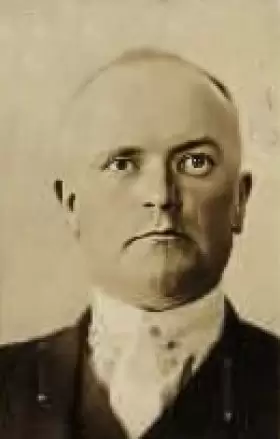
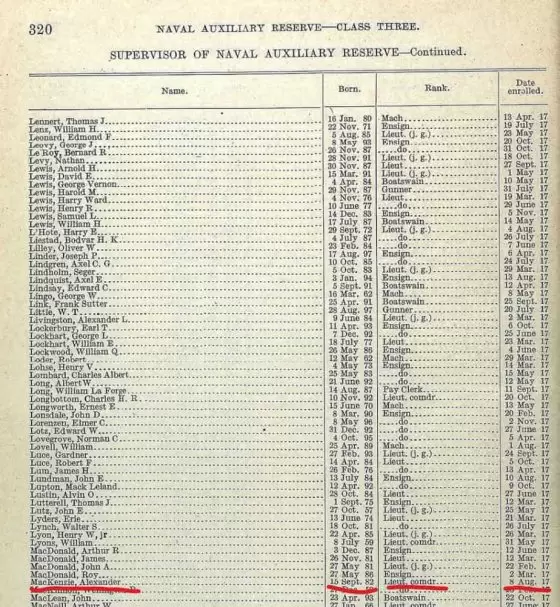
Naval Service
Alexander MacKenzie was enrolled in the US Naval Auxilliary Reserve on 8 August 1917 in the rank of Lieutenant Commander.
USS Los Angeles
The SS Los Angeles was built by Union Iron Works at San Francisco, California, as a commercial tanker in 1916 for the Union Oil Company of California. The U.S. Navy acquired her from Union Oil in 1917 for World War I service under a bareboat charter, gave it the naval registry Identification Number 1470, and commissioned it as USS Los Angeles on 9 August 1917 at New Orleans, Louisiana, with Lieutenant Commander Alexander Mackenzie in command. During the remainder of 1917, Los Angeles operated along the United States East Coast and United States Gulf Coast and made two cruises with the Atlantic Train Force.
On 9 January 1918, Los Angeles was assigned to duty with the Naval Overseas Transportation Service and, after loading cargo at New York City, departed New York on 15 January 1918 for the British Isles. It reached Scapa Flow in the Orkney Islands on 4 February 1918, discharged its cargo there, and departed on 7 February 1918 for the United States East Coast, where it arrived on 27 February 1918.
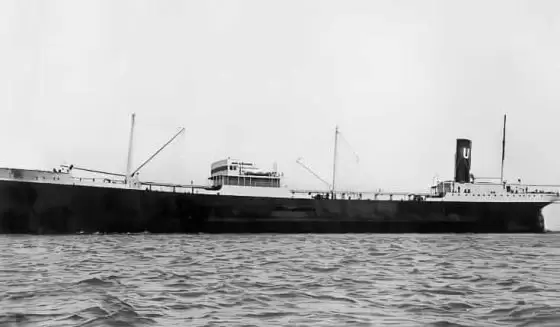
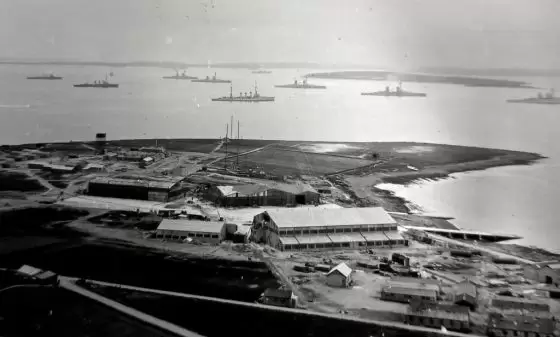
Scapa Flow 1919
When Sandy MacKenzie ran away from home and left Lewis in 1899 it was “for ever”, never to return. By a cruel irony, he would have sailed his ship the USS Los Angeles past his childhood home on the Isle of Lewis on his way to Scapa Flow in Orkney in February 1918, with a cargo of fuel oil for the war effort. I can’t help wondering if he plotted a route close inshore to Lewis to “salute” the island of his birth, although I know that a professional seaman like Sandy would never endanger his vessel for such sentimentality.
On 4 March 1918, Los Angeles departed New York for Port Arthur, Texas. Arriving there on 10 March 1918, she loaded fuel oil before departing for Hampton Roads, Virginia, on 14 March 1918. It arrived at Hampton Roads on 20 March 1918, then departed on 21 March 1918 to join a convoy bound for Europe. Between 21 March 1918 and 10 November 1918, Los Angeles made four transatlantic runs out of United States East Coast ports, carrying fuel oil to Brest in France and to Portsmouth and Devonport in England.
During the latter part of November 1918, Los Angeles transported a cargo of fuel oil from Philadelphia, Pennsylvania, to Cristóbal in the Panama Canal Zone. After loading crude oil at Tuxpan, Mexico, it returned to New York on 16 December 1918. Los Angeles was decommissioned at New York on 17 January 1919 and was returned to Union Oil the same day.
SS Vaterland
SS Leviathan was an ocean liner launched on 3 April 1913 and began service in 1914 as the transatlantic ocean liner Vaterland for Germany’s Hamburg America Line. The ship, second of three running mates and then the largest passenger ship in the World, made its first voyage to New York arriving on 21 May 1914 under the command of a Commodore and four Captains of the German Naval Reserve to celebrations featuring German and American officials at the line’s Hoboken facilities.
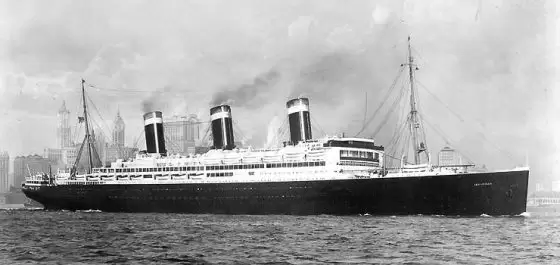
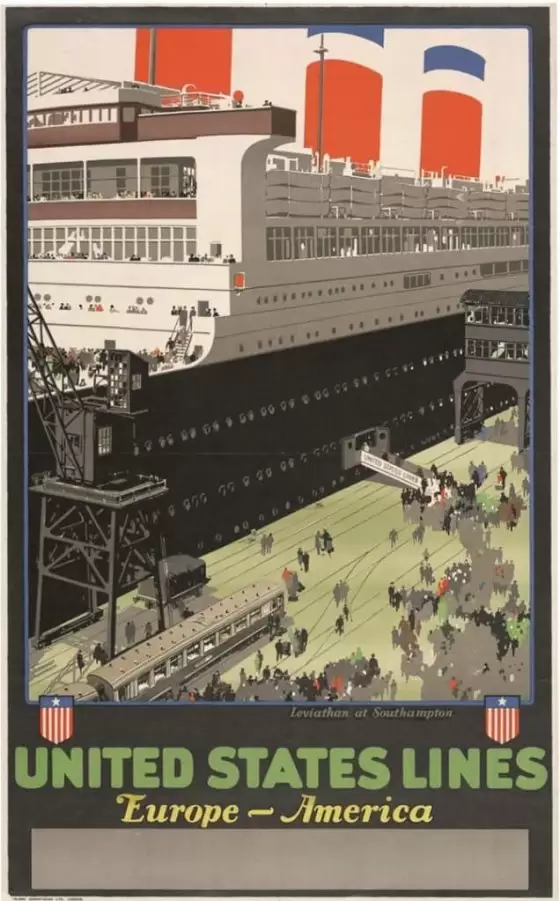
SS Leviathan
With US entry into the war in 1917 Vaterland and the German line’s Hoboken facility were seized by the US government. The ship was placed under the control of the United States Shipping Board and in July 1917 to the Navy for completion of repairs and conversion to a troop ship. In July 1917 the ship was commissioned as the USS Vaterland and on 6 September 1917 renamed Leviathan and assigned to the Cruiser and Transport Force. The ship’s first troop transport voyage departed New York on 17 December 1917 with 7,250 troops
During the war the ship made ten round trips transporting more than 119,000 troops to Europe. That process was reversed after the war with the ship’s last voyage with returning troops arriving on 8 September 1919. The ship was decommissioned and turned over to the Shipping Board on 29 October 1919, remaining laid up at Hoboken until April 1922.
USS Hoven
After the Los Angeles was decommissioned, Sandy served as Master of the USS Hoven, an oil tanker of 14,530 tons and a length of 453 feet. This ship was decommissioned at the end of the first world war and was eventually sold to Standard Oil.
When the USS Hoven was decommissioned by the US Navy, she was returned to the US Shipping Board, by whom Alexander Mackenzie seems to have been employed.
The United States Shipping Board (USSB) was established as an emergency agency by the 1916 Shipping Act, on 7 September 1916. The United States Shipping Board’s task was to increase the number of US ships supporting the World War One efforts. United States Shipping Board program ended on 2 March 1934.
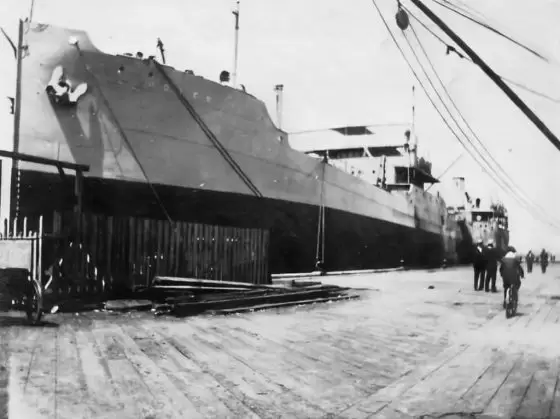
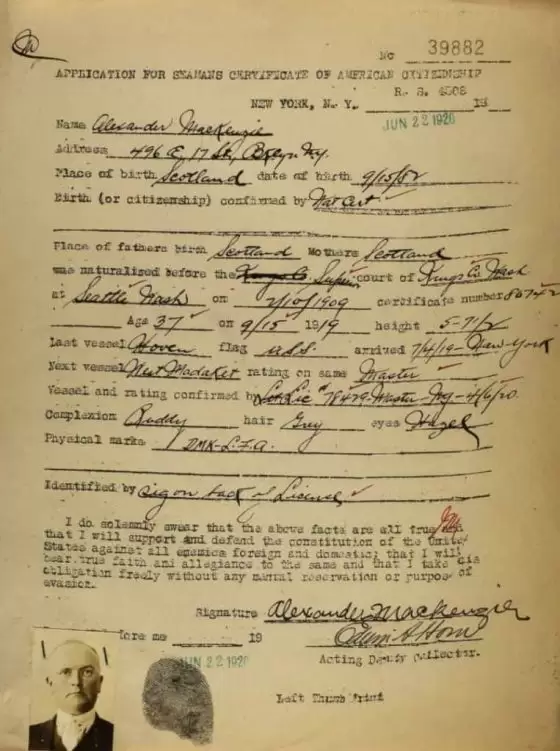
US Citizenship
The document opposite shows that Alexander MacKenzie was naturalized in Seattle Washington on 10 February 1909. He then applied for a Seaman’s Certificate of American Citizenship on 15 September 1919.
Alexander gives his address as 496 East 17th Street, Brooklyn which is a large house in quite an affluent area of New York. In the 1920 census Alexander is found living in East 69th Street lodging with the family of Peter Teksmo. As his ship was moored at 69th Street Pier, perhaps he took lodgings locally to be near his ship.
The application also confirms that his next position will be as master of the West Madaket, where he will be appointed as Master on 6 April 1920.
East 17th Street, Brooklyn Today
The red arrow marks the position of 496 East 17th Street, Brooklyn, as it is today.

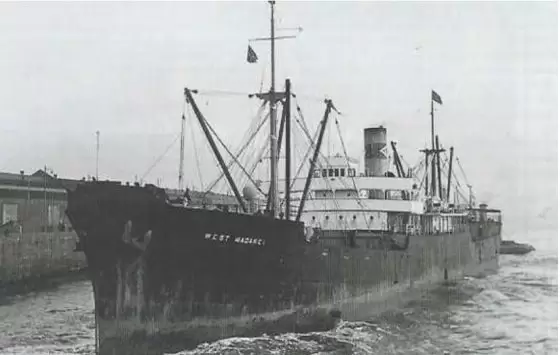
SS West Madaket
West Madaket was built in 1918 as a commercial cargo ship at Seattle, Washington by the Skinner and Eddy Corporation. Launched on 5 October 1918, she was acquired by the U.S. Navy for World War I service upon completion on 31 October 1918, and commissioned the same day as USS West Madaket at Puget Sound Navy Yard, Bremerton, Washington.
Assigned to the Naval Overseas Transportation Service, West Madaket completed her sea trials too late to see service before World War I ended on 11 November 1918. She departed for the United States East Coast on 18 November 1918 with a cargo of 7,031 tons of flour consigned to European food relief. Voyaging via the Panama Canal, she arrived at New York City on 16 December 1918 and departed on 22 December 1918, bound for Europe. She made port at Falmouth, England, on 5 January 1919 and pushed on, that same day, for Rotterdam, the Netherlands, where she discharged her cargo until 23 January 1919.
Returning to New York on 9 February 1919, West Madaket loaded 6,841 tons of general cargo and made a voyage to Le Verdon-sur-Mer, France, returning to New York on 28 April 1919.
MacKenzie’s Ex-Meridian Altitude Tables
Sometime between arriving in New York and 1920 when he published his book, Alexander seems to have been busy creating a mathematical solution to the Ex-Meridian Problem.
“A seaman always knows his latitude”, is an ancient proverb which, although seldom uttered in this age of electronic navigation, emphasizes the importance the old-time seaman attached to knowledge of latitude. After the advent of position-line navigation due to Captain Sumner’s discovery in 1837, astronomical navigation was brought to a state of excellence by the French naval officer Marcq. St. Hilaire.
Thereafter the problem of finding latitude at sea by astronomical navigation became merely a special case of the general method of obtaining an astronomical position line. The end product of every sight for position finding at sea is a position line which may be, but seldom is in practice, drawn on a chart or plotting sheet.
I believe the book of tables which my father inherited was Sandy’s own copy as it includes six testimonial letters sent to him. What I particularly like about this book is the stain of a coffee cup on the front cover. It suggests to me that this book had pride of place at Sandy’s workstation on the bridge.
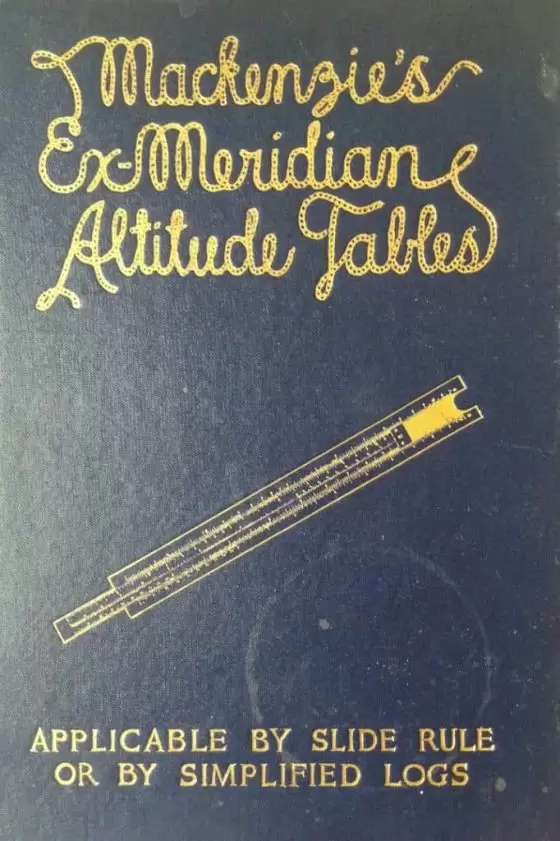
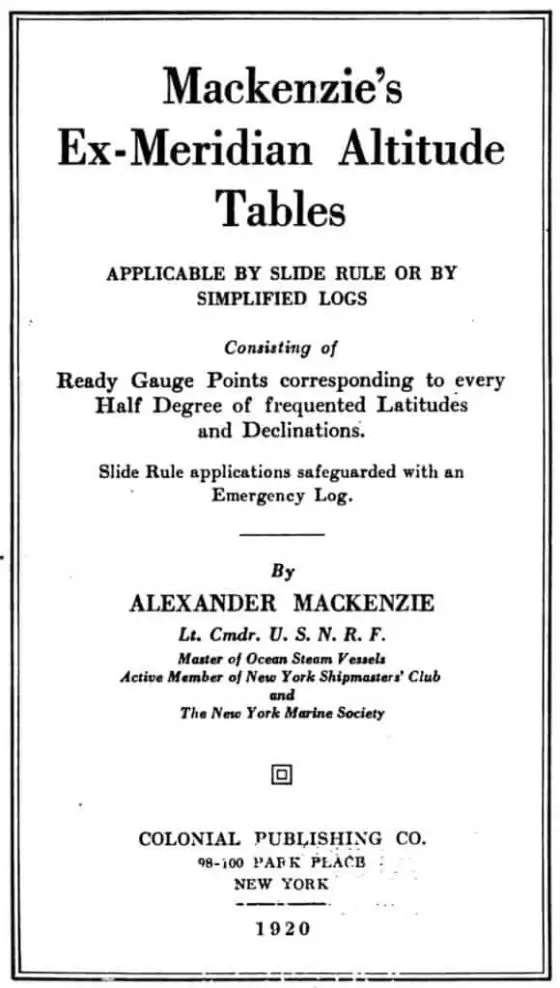
Frontispiece to Tables
Old established practices die hard at sea: so much so that in spite of the fact that position-line navigation was introduced no less than a century and a quarter ago, many present-day navigators seldom think in terms of position lines.
Many think in terms of ‘latitude by meridian altitude’; ‘latitude by ex-meridian’; ‘latitude by pole star’; or ‘longitude by chronometer’: as their seafaring fathers and grandfathers did before them.
The troublesome disadvantage of the midday Sun sight is that the Sun and the horizon vertically below him must be visible at one particular instant of time during the day. It is not surprising, therefore, that in pre-position line days the enterprising seaman aimed to provide himself with alternative methods for finding latitude.
Latitude, together with Lead, Log, and Lookout, had become one of the four L’s of the navigator long before the Mariner’s Creed had been penned by that well-known Secretary to the Board of Trade, Thomas Gray.
Explanation of Tables
An explanation is offered, but which sadly leaves me none the wiser as to the intricacies of the solution.
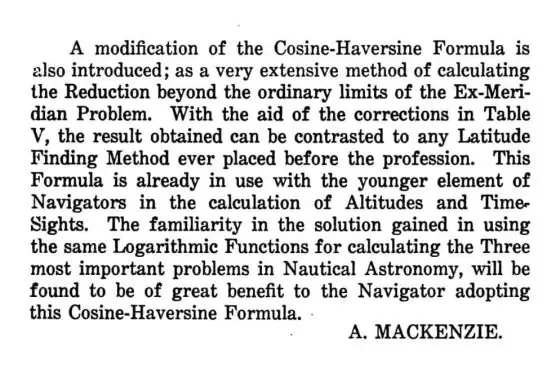
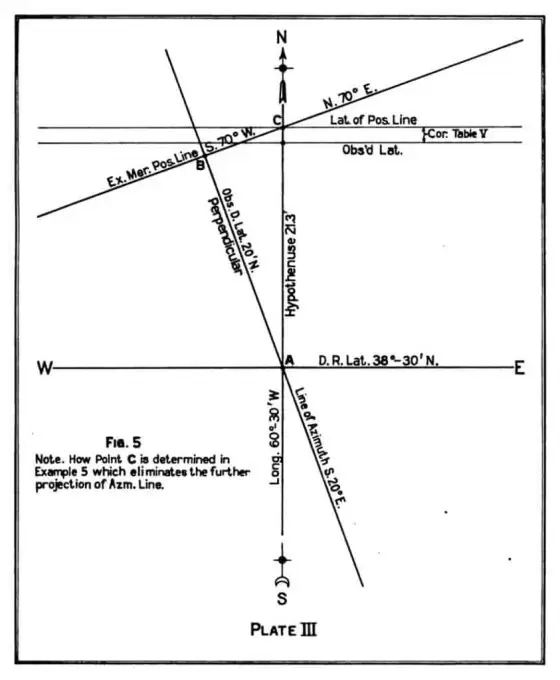
Latitude Diagram
A diagram to help explain how the tables enable a sighting to be adjusted to correct a reading that could not be taken at noon.
Example of Using Tables to calculate Latitude
This page from Alexander’s book provides a clearly worked example of how the tables would be used in a real world example.
All I can say is that many sailors must have welcomed the arrival of GPS Satellite Location.
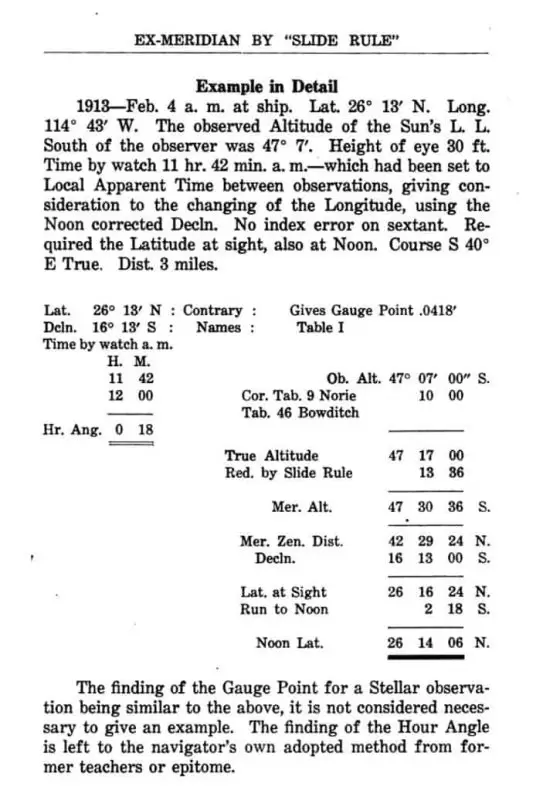
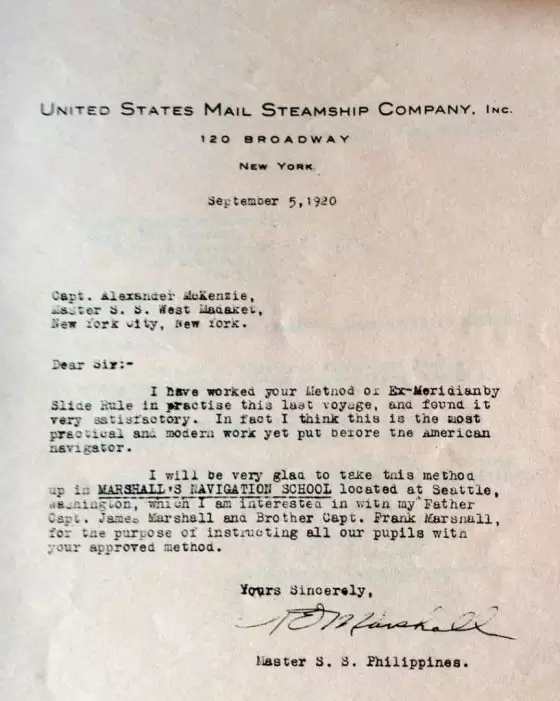
Testimonial Letter
This testimonial letter was found loose in our copy of MacKenzie’s Tables, along with five or six other similar letters.
The letter was sent to Alexander MacKenzie, Master SS West Madaket, New York City. Presumably the US Postal Service knew how to deliver this mail when the ship was at sea.
Apparently my Aunt, Jessie Ann Thomson met Sandy when she lived in New York. She arrived in New York in 1930, two years before Sandy died. She told the story that Sandy took them them to the cinema and was very proper, but concerned that the content of the film might offend her strict presbyterian upbringing.
Jessie also mentioned that he had a yacht, moored on the Hudson river, and he took her on board. This seems an unusual berth for a leisure yacht and I can’t help wondering whether she meant ‘ship’, as the SS West Madaket was moored permanently on the Hudson at 69th Street Pier, and used as administrative offices for the US Shipping Board.
Jessie stayed in New York and was eventually married in the Presbyterian Church in Manhattan on 18 July 1935.
Death Certificate
Alexander MacKenzie died on 7 September 1932 from a heart attack at the age of 50. He was living in Hampton Virginia and he was buried in the Veterans Affairs National Cemetery in Hampton on 12 September 1932. He never married and left no children.
